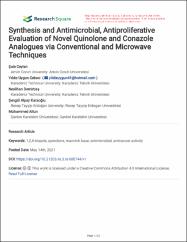| dc.contributor.author | Ceylan, Şule | |
| dc.contributor.author | Cebeci, Yıldız Uygun | |
| dc.contributor.author | Karaoğlu, Şengül Alpay | |
| dc.contributor.author | Altun, Muhammed | |
| dc.date.accessioned | 2022-09-08T07:05:07Z | |
| dc.date.available | 2022-09-08T07:05:07Z | |
| dc.date.issued | 2021 | en_US |
| dc.identifier.citation | Ceylan, S., Cebeci, Y.U., Karaoglu, S.A. & Altun, M. (2021). Synthesis and Antimicrobial, Antiproliferative Evaluation of Novel Quinolone and Conazole Analogues via Conventional and Microwave Techniques. Chemistryselect, 6(35), 9467-9476. https://doi.org/10.1002/slct.202101840 | en_US |
| dc.identifier.issn | 2365-6549 | |
| dc.identifier.uri | https://doi.org/10.1002/slct.202101840 | |
| dc.identifier.uri | https://hdl.handle.net/11436/6404 | |
| dc.description.abstract | 1,2,4-Triazole-3-one (3), acquired from cinnamaldehyde was converted to the corresponding carbox(thio)amides via several steps (6 a-c). Their reaction with sodium hydroxide gave the 1,2,4-triazole derivatives (7 a-c). Compound 3 treatment with 2-bromo-1-(4-chlorophenyl) ethanone or 2-chloro-1-(2,4-dichlorophenyl)ethanone afforded the compounds 8 a,b and by reducing these compounds reduction products were obtained (9 a,b). The synthesis of (10 a-e) was carried out by the reaction compounds 9 a,b with different benzyl chlorides. Then oxadiazole derivative (12) was obtained by ring closure from hydrazide compound 5. Subsequently compounds 3, 7 a-c, and 12 were treated with various amines in the presence of formaldehyde to yield Mannich bases (11 a-e, 14 a-e, 13 a,b). Microwave-assisted and conventional techniques were utilized for the syntheses. The structures of newly synthesized compounds were illuminated by spectroscopic methods. Their antimicrobial (MIC method), and anticancer activities (Abay's method) were examined. Results showed that most of the compounds exhibited good antimicrobial activities. Especially compounds 14 a-e which is a mannich base showed very good antitubercular activity against Mycobacterium smegmatis compared with Streptomycin standard drug. Also compounds 8 a and 9 b have been found to have strong antiproliferative effects on the HeLa cervical cancer cells and also these compounds did not have a cytotoxic effects on a normal cells. | en_US |
| dc.language.iso | eng | en_US |
| dc.publisher | Wiley | en_US |
| dc.rights | info:eu-repo/semantics/openAccess | en_US |
| dc.subject | Anticancer | en_US |
| dc.subject | Antimicrobial activity | en_US |
| dc.subject | Mannich base | en_US |
| dc.subject | 4-triazole | en_US |
| dc.subject | Quinolone | en_US |
| dc.title | Synthesis and antimicrobial, antiproliferative evaluation of novel quinolone and conazole analogues via conventional and microwave techniques | en_US |
| dc.type | article | en_US |
| dc.contributor.department | RTEÜ, Fen - Edebiyat Fakültesi, Biyoloji Bölümü | en_US |
| dc.contributor.institutionauthor | Karaoğlu, Şengül Alpay | |
| dc.identifier.doi | 10.1002/slct.202101840 | en_US |
| dc.identifier.volume | 6 | en_US |
| dc.identifier.issue | 35 | en_US |
| dc.identifier.startpage | 9467 | en_US |
| dc.identifier.endpage | 9476 | en_US |
| dc.relation.journal | Chemistryselect | en_US |
| dc.relation.tubitak | 113Z181 | |
| dc.relation.publicationcategory | Makale - Uluslararası Hakemli Dergi - Kurum Öğretim Elemanı | en_US |


















